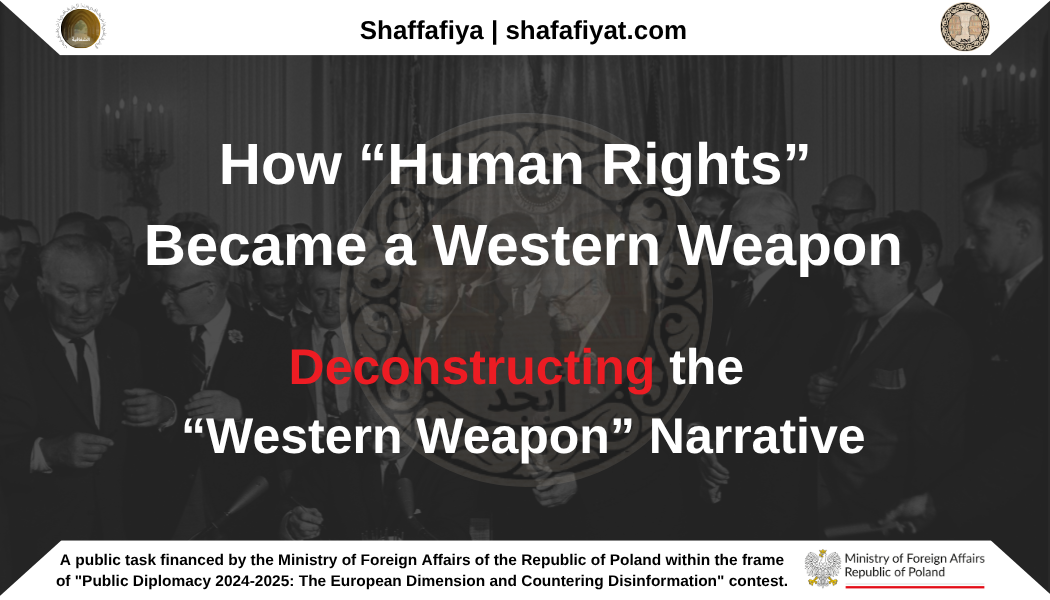
Klarenberg’s article on the 50th anniversary of the Helsinki Accords, exploring how the West transformed the concept of “human rights” into an instrument of subversion, regime change, and intervention.
In the evolving landscape of political and information warfare, narratives surrounding “human rights” have often been used to shape legitimacy and delegitimise adversaries. In an article published on the anniversary of the Helsinki Accords, investigative journalist Kit Klarenberg advances a provocative thesis: that the West appropriated “human rights” after 1975, converting them from a universal principle into a political weapon. By privileging civil and political freedoms while ignoring socio-economic rights, and by embedding monitoring bodies within Eastern Bloc societies, the West is presented as having engineered a Trojan horse that contributed to the eventual downfall of the Soviet Union and its allies.
This analysis deconstructs Klarenberg’s argument, situating it within the broader strategic repertoire of Cold War subversion, and considers its implications for today’s information environment.
Deconstructing the “Western Weapon” Narrative
Klarenberg highlights how the Helsinki Final Act focused on freedoms of expression, assembly, and movement, while excluding guarantees central to socialist systems, such as housing, employment, and education. This emphasis institutionalised a Western-centric rights framework.
Creation of Monitoring Mechanisms
He traces the rise of Helsinki Watch (later Human Rights Watch), which monitored Eastern Bloc compliance, forged ties with dissident groups, and broadcast findings globally. By contrast, no reciprocal oversight of the United States or NATO states was envisaged.
Dissident Networks and Western Support
The article details how Solidarity in Poland and Charter 77 in Czechoslovakia grew into mass movements underpinned by covert Western aid. Klarenberg cites declassified US National Security Directives which explicitly tasked Washington with loosening Soviet control, promoting liberalisation, and reintegrating Eastern Europe into the Western order.
Transition and Shock Therapy
Klarenberg emphasises that the fall of Communism was followed not by universal prosperity but by traumatic economic transitions. Rapid privatisation produced unemployment, inequality, and social insecurity, which the Western “human rights” framework dismissed as outside its scope.
Interpretative Commentary
Klarenberg’s construction of the narrative reflects several disinformation and framing techniques:
- False Equivalence: Eastern Bloc social guarantees are presented as equal or superior to Western civil rights, overlooking systemic repression and lack of pluralism.
- Cherry-Picking and Omission: Western support for dissidents is heavily emphasised, but the grassroots agency of local activists and the stifling control of Communist regimes are minimised.
- Emotional Framing: By linking “human rights” directly to the disillusionment of the 1990s, the narrative stokes nostalgia and resentment, portraying the West as both manipulative and hypocritical.
The West’s Geopolitical Playbook
Klarenberg frames the Helsinki process as a deliberate Western strategy of political warfare:
– Delegitimisation: By codifying rights selectively, the West could indict adversaries while immunising itself from scrutiny.
– Instrumentalisation: Dissident groups became vectors of Western influence, supported with printing presses, communications equipment, and covert funds.
– Democracy Promotion as Intervention: US programmes channelled millions into sustaining movements that eventually displaced Communist governments.
– Strategic Objective: Declassified directives confirmed the goal of integrating Eastern Europe into the Western political and economic system, undercutting Moscow’s sphere of influence.
Interpretative Commentary
This narrative portrays “human rights” as an early form of cognitive and political warfare. It suggests that the moral power of rights was weaponised to delegitimise adversaries, destabilise regimes, and advance systemic transformation aligned with US interests. By cloaking subversion in the language of morality, Western states blurred the line between advocacy and intervention.
Conclusion
Kit Klarenberg’s article reframes the Helsinki Accords as a turning point in the weaponisation of human rights. By privileging civil and political rights while excluding socio-economic guarantees, the West is depicted as having built an ideological framework for destabilisation, exploited through dissident networks and covert funding, culminating in the collapse of the Eastern Bloc.
The narrative is compelling because it blends archival truth – US directives, covert funding, shock therapy outcomes – with omissions that erase the pervasive repression, censorship, and lack of freedoms that defined life under Communist regimes.
For today’s defence community, the lesson is clear:
– Human rights discourse remains contested terrain in information warfare.
– Historical reinterpretations can delegitimise the post-1989 order and strengthen authoritarian counter-narratives.
– Effective defence requires integrating socio-economic and civil-political dimensions of rights to prevent adversaries from exploiting accusations of hypocrisy.
In the era of cognitive conflict, history itself has become a weapon. Countering these narratives requires not only factual correction but also the reaffirmation of a consistent, universal human rights framework – one that adversaries cannot so easily recast as an instrument of domination.
The weaponisation of “human rights” illustrates how even the noblest concepts can be repurposed as instruments of power. By reframing Helsinki as a covert offensive rather than a diplomatic compromise, this narrative seeks to erode trust in Western legitimacy and present democracy promotion as merely a façade for imperial ambition. Such reinterpretations, while persuasive to disillusioned publics, risk obscuring the lived reality of repression under the Eastern Bloc and weakening the universal claim of rights themselves. For policymakers and defence communities, the task is not only to expose selective histories but to demonstrate coherence between values and practice. Only through consistency, integrating political freedoms with socio-economic protections, can democracies neutralise adversarial disinformation and preserve the credibility of the international order in an age where history itself has become a battlefield.

